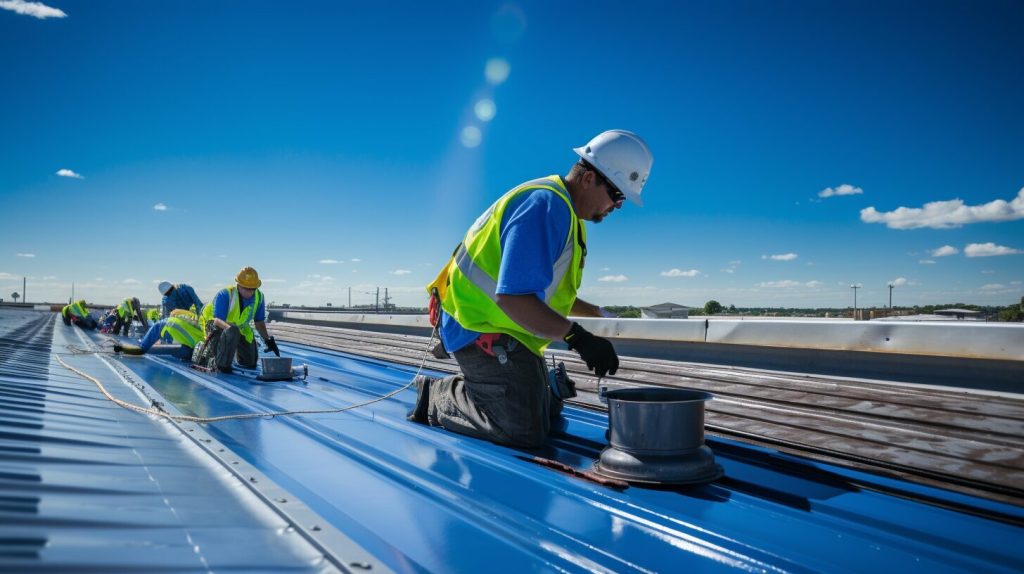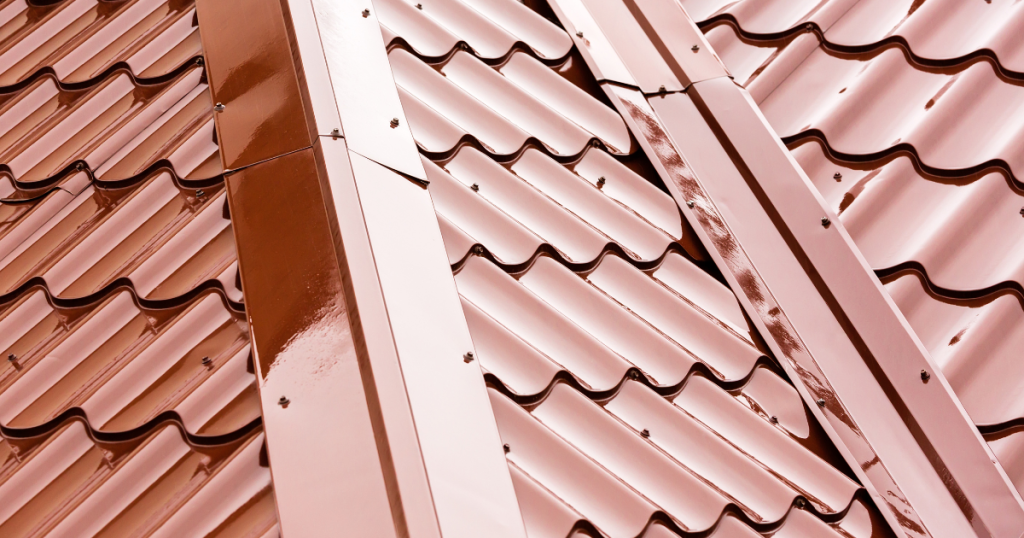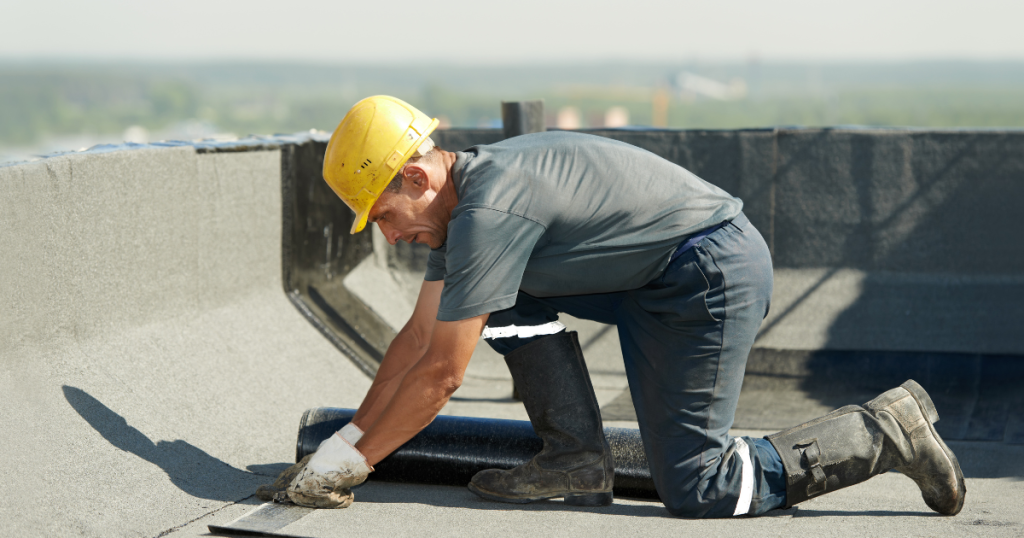Welcome to our comprehensive guide on commercial roof maintenance. As a business owner, you know that keeping your property in top condition is essential for the success of your operations. However, one area that is often overlooked is the roof. A properly maintained commercial roof can protect your business from costly damages and ensure that your employees and customers stay safe and dry.
In this section, we will provide you with a commercial roof maintenance checklist and valuable roof maintenance tips to help you ensure the longevity of your commercial roof. Let’s get started!
Key Takeaways:
- Regular commercial roof maintenance is crucial for protecting your business and ensuring its longevity.
- A commercial roof maintenance checklist can help you identify potential issues early on and prevent costly repairs.
- Proactive roof maintenance can save you money in the long run by preventing major damages and extending the life of your roof.
- Clearing debris, inspecting roof flashing, and maintaining drainage systems are all essential roof maintenance practices.
- Addressing roofing material issues can protect your investment and ensure the integrity of your commercial roof.
Understanding the Importance of Commercial Roof Maintenance
At our company, we believe that regular commercial roof maintenance is crucial for the overall health of your business. A proactive roofing maintenance plan can save you money in the long run and ensure the longevity of your commercial roof. By ignoring regular maintenance, you run the risk of costly damages and disruptions to your business operations.
At our company, we recommend implementing a roofing maintenance plan that includes regular inspections and addressing potential issues before they become major problems. This plan should be tailored to the specific needs of your commercial building roof maintenance and should take into account the age and type of roofing material used.
Regular inspections allow you to identify potential issues early on and address them before they cause significant damage. This could include identifying cracks or leaks and fixing them before they worsen. With a proactive maintenance plan, you can avoid costly repairs and extend the life of your commercial roof.
At our company, we understand that commercial roofing maintenance can be overwhelming and time-consuming. That’s why we recommend seeking the help of professionals who can provide you with the expertise and guidance you need to maintain your commercial roof. By working with a professional, you can ensure that your roof is properly maintained and functioning optimally.
Conducting Regular Roof Inspections
Regular roof inspections are a crucial part of maintaining a commercial roof in good condition. By identifying potential issues early on, you can prevent costly damages and extend the lifespan of your roof. Here is a comprehensive roof inspection checklist to help you get started:
| Inspection Area | What to Look For |
|---|---|
| Roof Surface | Cracks, punctures, holes, blistering, bubbles, ponding water, mold, mildew, or other damage. |
| Flashings and Roof Edges | Loose, cracked, or missing flashing or edge metal, damaged coping, or deteriorated sealant. |
| Rooftop Penetrations | Damage to vents, pipes, HVAC units, skylights, or other rooftop equipment. |
| Gutters and Downspouts | Clogs, debris accumulation, or damage to gutters and downspouts. |
When conducting an inspection, it’s important to follow proper safety protocols and use appropriate gear, such as harnesses and hard hats. If you are unsure about any aspect of the inspection, it’s best to consult with a professional roofing contractor.
Once you have identified any potential issues with your commercial roof, it’s critical to address them promptly. Delaying repairs can lead to more extensive damage and higher repair costs. By maintaining a regular roof inspection schedule and promptly addressing any issues, you can ensure the longevity and optimal performance of your commercial roof.
Cleaning and Clearing Debris
One of the most important roof maintenance best practices is keeping your commercial roof clear of debris. Debris accumulation can lead to clogged drains, damaged roofing material, and even leaks. Here are some tips to help you effectively remove debris:
- Regularly remove leaves, twigs, and other debris from your roof. This will help prevent clogs in your drainage system.
- Clean out your gutters and downspouts at least twice a year, or more often if necessary.
- Trim any tree branches that may be hanging over your roof to prevent debris from falling onto it.
By implementing these practices, you can prevent debris build-up and ensure that your commercial roof stays in top condition.
Checking and Repairing Roof Flashing
One crucial aspect of commercial roof maintenance that often goes overlooked is checking and repairing roof flashing. Flashing is the metal material that is installed around roof edges, chimneys, and vents to prevent water from seeping into the building.
It’s important to check flashing regularly for signs of damage or wear and tear. Any cracks or gaps in the flashing can allow water to penetrate the roof and cause leaks and water damage to the building’s interior.
How to Check Roof Flashing
When conducting a roof inspection, pay close attention to the flashing on the roof. Look for any visible signs of damage, such as cracks or rust spots. Ensure that the flashing is tightly secured to the roof and is not lifting or pulling away from the surface.
Another way to check for damage is to run a hose over the flashing and observe the water runoff. If the water is not flowing smoothly or is pooling in certain areas, it’s a sign that there may be damage to the flashing that needs to be repaired.
Repairing Roof Flashing
If you notice any damage to the flashing during your inspection, it’s crucial to repair it promptly to prevent further damage to the roof and the building’s interior. Small cracks can be sealed with roofing cement, while larger cracks may require a more extensive repair or replacement of the flashing.
It’s important to hire a professional roofing contractor to repair any flashing issues to ensure that the repair is done correctly and effectively. Attempting to repair flashing without the necessary expertise can lead to further damage and costly repairs down the road.
Regularly checking and repairing roof flashing is one of the many essential tasks included in a commercial roof maintenance checklist. By following these roof maintenance tips, you can ensure that your roof remains in optimal condition, protecting your business from water damage and costly repairs.
Maintaining Roof Drainage Systems
Proper roof drainage maintenance is crucial to avoid water accumulation and subsequent damage to your commercial building. Clogged gutters and downspouts can lead to water pooling on your roof, which can weaken the structure and cause leaks.
Our roof maintenance schedule includes regular cleaning of gutters and downspouts to ensure proper water flow. This includes removing debris such as leaves, twigs, and dirt. We also check for any signs of damage to the drainage system, such as cracks or loose connections, and repair them promptly.
In addition to cleaning and repair, we also install gutter guards to prevent debris from entering the system and causing clogs. These guards allow water to flow freely while keeping out leaves and other debris.
Another essential aspect of roof drainage maintenance is ensuring that downspouts are properly directed away from the building’s foundation. This prevents water from pooling around the foundation, which can cause structural damage and water infiltration.
Our commercial building roof maintenance experts recommend checking your roof drainage system after heavy rainfalls or storms to ensure that water is flowing correctly. If you notice any issues, address them promptly to avoid more significant problems down the road.
Addressing Roofing Material Issues
As we have discussed, maintaining a commercial roof requires regular inspections and proactive maintenance. In addition to these best practices, it is important to address any potential issues with your roofing materials.
Common issues with roofing materials include cracks, punctures, and wear and tear. These issues can lead to leaks and water damage, compromising the integrity of your commercial roof.
Identifying Issues
The first step in addressing roofing material issues is identifying them. Regular inspections can help you catch potential issues before they become major problems. Look for any signs of damage or wear, such as cracks or discoloration.
If you notice any issues, it is important to address them as soon as possible to prevent further damage.
Repairing or Replacing Materials
Depending on the severity of the issue, you may need to repair or replace your roofing materials. Small cracks or punctures can often be repaired with sealant, while larger damage may require replacing the damaged section.
It is important to hire a professional roofing contractor to handle any repairs or replacements. They have the expertise and equipment needed to ensure the job is done correctly and safely.
Preventing Future Issues
Regular maintenance is key to preventing future roofing material issues. Keep your roof clear of debris, and address any potential issues as soon as they arise.
In addition, consider using high-quality roofing materials that are designed to withstand the elements and provide long-lasting protection for your commercial building.
By addressing roofing material issues promptly and proactively preventing them, you can ensure the longevity and performance of your commercial roof for years to come.
- Commercial roofing maintenance
- Roof maintenance best practices
Conclusion
We hope that this commercial roof maintenance checklist has provided you with valuable tips and insights on how to ensure the longevity and optimal performance of your commercial roof. By implementing a proactive roofing maintenance plan, you can save your business from costly damages and maintain a dry and secure environment.
Remember to conduct regular roof inspections, keep your roof clear of debris, inspect and repair roof flashing, maintain roof drainage systems, and address roofing material issues as they arise. By following these best practices, you can protect your investment and avoid unexpected expenses related to roof repairs or replacements.
Don’t forget to schedule periodic maintenance checks and consult with a professional commercial roofing contractor to ensure that your roof is in top condition. We hope that this checklist serves as a useful guide in your commercial building roof maintenance efforts.
Thank you for reading, and remember to prioritize your commercial roof maintenance and follow a comprehensive roofing maintenance plan.
FAQ
What is commercial roof maintenance?
Commercial roof maintenance involves regular inspections, cleaning, and repairs to ensure the longevity and optimal performance of a commercial roof.
Why is commercial roof maintenance important?
Commercial roof maintenance is important because it helps protect your business from costly damages caused by leaks, water damage, and other roofing issues.
How often should I conduct roof inspections?
It is recommended to conduct roof inspections at least twice a year, preferably in the spring and fall, to identify and address any potential issues promptly.
How can I effectively clean and clear debris from my commercial roof?
To effectively clean and clear debris from your commercial roof, use a broom or leaf blower to remove leaves, branches, and other loose objects. Be sure to exercise caution and follow safety guidelines when performing this task.
What is roof flashing and why is it important to maintain it?
Roof flashing is a material used to prevent water from seeping into the joints and seams of your commercial roof. It is important to maintain roof flashing to prevent leaks and water damage.
How can I maintain the drainage system on my commercial roof?
To maintain the drainage system on your commercial roof, regularly inspect and clean the gutters and downspouts, ensuring that they are free from debris and functioning properly.
What are some common roofing material issues and how can I address them?
Common roofing material issues include cracks, blistering, and curling. To address these issues, you may need to repair or replace damaged roofing materials, seal cracks, and ensure proper installation.




